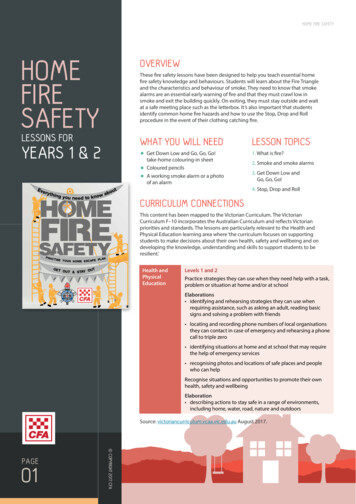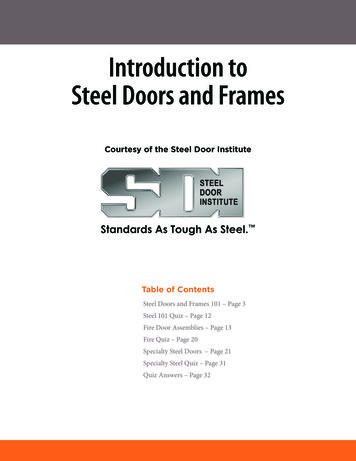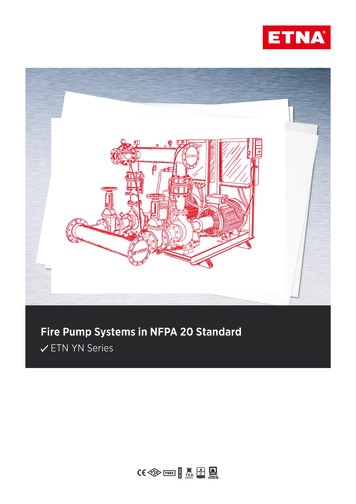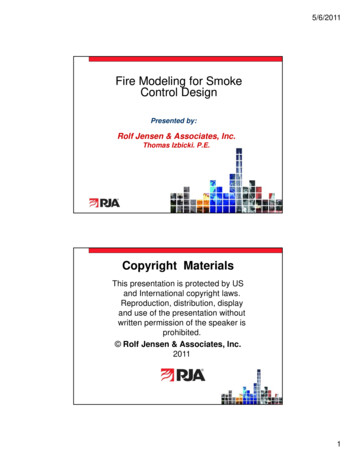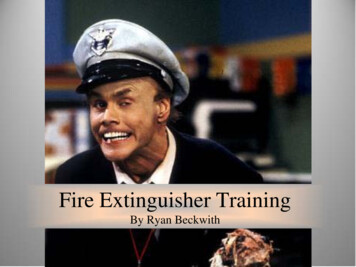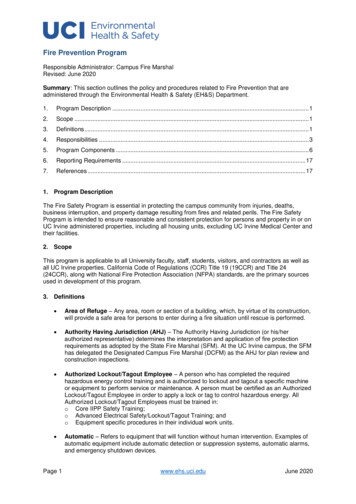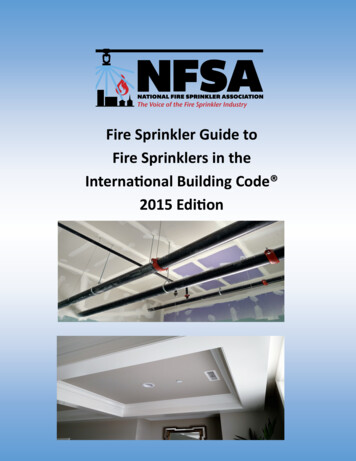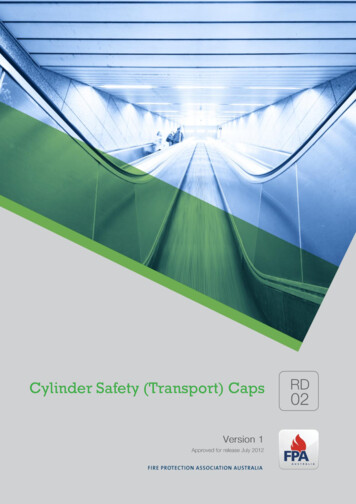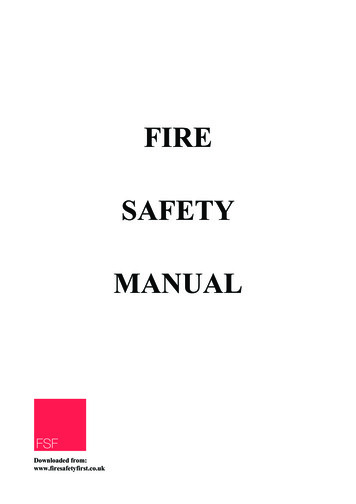
Transcription
FIRESAFETYMANUALFSFDownloaded from:www.firesafetyfirst.co.uk
ContentsPageIntroductioniiSection 1 – Practical Fire Safety Guidance1/1Section 2 – Fire Safety Training2/1Section 3 – Log-book3/1Fire Safety Manuali
IntroductionThe purpose of this manual is to assist private and public sector clients in meeting theirresponsibilities for maintaining adequate fire safety in all premises which they occupy.The manual sets out the general procedures and precautions to be followed and outlines the use andcare of fire fighting equipment. Precautions to be taken in respect of certain specific circumstancesare also included.It is important that fire safety systems are tested and procedures monitored on a routine basis. Theback of the manual contains standard forms for recording the execution of fire drills, inspectionsand equipment tests.cupied premises.A copy of the manual should be available in all occupiedThis fire safety manual was provided by Fire Safety First, for more information please visit:www.firesafetyfirst.co.ukFire Safety Manualii
Section 1 – Practical Fire Safety GuidanceFire Safety Manual1/1
Insert sector specific fire safety guidancedocument for your type of premisese.g. if this manual is for an office;(England & Wales)print and insert the DCLG guide for ‘Offices and Shops’(Scotland)print and insert the Scottish guidance for ‘Offices, Shops and SimilarPremises’(Northern Ireland)print and insert the DHSSPS guide for ‘Offices and Shops’All sector specific guidance documents are free to download from the‘Downloads Publications’ page at www.firesafetyfirst.co.uk
Section 2 - Fire Safety TrainingContents1.Fire Precautions in the workplace2.Introduction3.Presentation Guidance Notes4.Support MaterialsInvitation to Fire Safety Training SeminarFire action card – FA1First day induction – guidance for fire safety trainingFire Safety Presentation Attendance SheetQuizFire Safety Manual2/1
IntroductionThis training pack is provided for those responsible for buildings to train their staff in compliancewith fire safety legislation. It includes:(a)Training Video – Fire Precautions in the Workplace(download free from www.firesafetyfirst.co.uk, burn onto a CD and keep a copy with thismanual)This lasts approximately 12 minutes and discusses –What people should do if they discover a fire or hear the fire alarmFire fighting equipment and it’s useLeaving the building and general fire safety.(b)Presentation Guidance NotesSome information has been provided stating what additional information should be given tostaff on matters specific to the building.(c)Supporting MaterialsMaster copies of other information have been provided; photocopies of these should bemade and used.Fire Safety Manual2/2
Presentation Guidance Notes1.PreparationThe main part of this presentation is a video. It covers the actions in the event of becoming awareof a fire and discovering a fire. The different types of portable equipment commonly found inbuildings and their use are also discussed. The video provides only general information and issuesspecific to your building will need to be addressed. You will need to gather some additional itemsthat will be used during and after the video; these will include;copy of fire action card;one of each type of extinguisher in the building (it is not intended that they be discharged),also ensure that the extinguishers are temporarily removed from a place of least risk near theseminar room and replaced immediately after the seminar) anda copy of the fire policy for your building.It is important that a record of this training is made and a form (Fire Safety First’s PresentationAttendance Sheet) has been provided at the end of this pack. This ‘master’ should be copied andthe copy retained in the Fire Safety Manual.2.Introduction to PresentationIt is suggested that a short introduction be given stating:who you are and your fire safety role;that training is necessary to ensure the health and safety of all people in the building;the format of the presentation i.e. a 12 minute video that will be paused at intervals todiscuss the fire action card and fire fighting equipment in this building anda final session in which building specific matters such as the fire policy will be discussedand questions taken.3.Training VideoThe training video contains breaks (indicated with a ‘!’) at the following points:Fire action card – it is intended that the action outlined on this card for your building is readat this point. You may wish to take a copy of the sample in this pack, photocopy it and fillin your details. You should also point out that fire action cards must always be at eachbreak glass point and, where there may be regular visitors or members of the public, onnotice boards.Fire fighting equipment – a space has been left after each type of extinguisher. People maywant to have a closer examination of each type of extinguisher or try and lift it. This shouldbe facilitated after the presentation is over. It will not be possible to discharge any of theextinguishers at this stage. If you do not have one or more of a particular type then it issufficient to watch the video. You should have a preliminary viewing to establish thelocation of these ‘pause points’.Fire Safety Manual2/3
4.Final SessionThis is an important part of the presentation in which the fire policy of the building should bediscussed. Matters that should be included are:fire alarm signals;escape routes;assembly point (note, at some very large city centre buildings this will be impractical);facilities for disabled people (including people with a hearing or visual disability ortemporary disabilities such as broken legs, advanced pregnancy etc); andemphasis of the importance of fire doors and the seriousness of wedging open doors tokitchens, stores and stairs etc.Areas of high fire risk in the building and general fire safety management should also be discussed.Time should be made available for questions; if you are unable to provide an immediate answer toany question then refer to your Fire Safety Manual, which provides an excellent source ofinformation. Further advice can also be sought from Fire Safety First, visit our website to contactour closest office.5.Presentation ReviewAt the end of the presentation(s) a review should be made for any points arising and actioned asrequired. Staff changes may necessitate training for yourself and/or fire wardens; this can bearranged either through your Departmental training officer or directly with Fire Safety First.6.QuizAn optional question sheet has been included in this pack; the correct answers are as follows:QuestionAnswerFire Safety Manual1C2B3A4B5C2/46B7A8C9A10A
Fire Safety Manual2/5
First day induction – guidance for fire safety trainingAll staff must receive appropriate Fire Safety Training as part of their First Day Induction. Thesample form provided below is offered as guidance in the matters that should be covered for generalstaff.First Day Induction – Fire Safety TrainingThe fire safety training of new employees including casual and part-time staff is vitally importantbecause untrained persons could be a danger to other staff and themselves.The following topics must be discussed with the post holder:Topic for discussionTick whencompleteConducted tour of the buildingFire warning systemMeans of escapeAssembly point after evacuationAction on discovering fireAction on hearing alarmLocation of nearest fire equipment and alarm pointNo smoking rulesAreas out of bounds to unauthorised peopleImportance of keeping gangways, exits etc. clear of obstructionsImportance of closing fire doorsI confirm that the above topics have been discussed, and any questions answered.Signed .(Line Manager)Date .I confirm that the above topics have been explained to me as part of my Induction Package.Signed .(Post holder)Date .The Line Manager should retain a copy of this form and return the original to Personnel as soon aspossible after induction has taken place.Fire Safety Manual2/7
Fire Safety PresentationAttendance SheetDateName(Please print)Fire Safety ManualName(Please print)2/8Name(Please print)
Quiz (circle or tick what you consider to be the correct answer – you will not be assessed)1.The fire evacuation signal is activated; do you –(a)wait for further instructions;(b)assume it’s a false alarm or(c)leave immediately via the nearest available exit route?2.You discover a fire in the kitchen, is your first action to (a)try and find the fire precautions officer;(b)shout fire and activate the fire alarm or(c)try and fight the fire?3.You see a fire door to a store wedged open; no one is around. Do you (a)remove the wedge and report it to the fire precautions officer;(b)leave it, someone might be coming back or(c)think that it’s handy for people carrying stationery in and out?4.If you discover a fire you (a)must try and fight it only if it is small;(b)only try and fight it if the alarm has been raised, you are able to escape and confident thatyou are able to extinguish it or(c)must try and fight it especially if it is likely to get out of control?5.Water extinguishers are suitable for (a)extinguishing electrical equipment fires;(b)extinguishing chip pan fires or(c)extinguishing solid fuel fires?6.CO2 Extinguishers are best for (a)liquid fires;(b)electrical fires or(c)solid fuel fires?7.Foam extinguishers have a panel colour that is (a)cream;(b)black or(c)red?8.An extinguisher with an all blue body is (a)out of date;(b)a carbon dioxide extinguisher or(c)a dry powder extinguisher?9.If the alarm stops while you are evacuating you should (a)continue to evacuate and report to your place of assembly;(b)stop and wait for further instructions or(c)return to work?10.Fire alarm ‘break glass’ points are commonly located (a)on escape routes near exit doors;(b)near kitchens or(c)inside large office rooms?Fire Safety Manual2/9
Section 3 – Log-bookIt is important that the execution of routine fire drills, inspections and equipment tests is recorded.The following record forms are included Record 1Fire Equipment – schedule.Record 2Fire drill and instruction.Record 3Fire alarm – inspection/test.Record 4Automatic fire detection system – event log.Record 5Automatic fire detection system – maintenance.Record 6Emergency lighting – inspection/test.Record 7Firefighting equipment – inspection/test.Record 8Firefighting water supplies – inspection/test.Record 9Sprinkler system – inspection/test.Record 10Standby generator supplying fire safety systems – inspection/test.Record 11Smoke control system – inspection/test.Record 12Fire door inspection/test.Fire Safety Manual3/1
Record 1Fire equipment – scheduleAddressTotal c/fTotalFire Safety Manual3/2Fire HydrantWet or Dry RiserFire Alarm GongFire Alarm Call PointFire BucketFire BlanketBCF ext.CO2 ext.Dry Powder Ext.Foam Ext.Water Ext.Location ofappliancesHose ReelCompleted by Checked by (Fire Officer)
Record 2DateFire drill and instructionType of drillor instructionFire Safety ManualNumber of staffattendingTest evacuationtime3/3RemarksSignature
Record 3DateFire alarm – inspection/testCall pointtestedFire Safety ManualResultAction takenregarding defects3/4Time resetconfirmedSignature
Record 4DateandtimeAutomatic fire detection system – event logLocation orzoneFire Safety ManualCounterreading (ifinstalled)Event(fire, false alarm,fault, test,maintenance etc.)3/5Action takenor requiredSignature
Record 5Automatic fire detection system - maintenanceEnter nature of workcarried out; faultcorrected or othercomplaintFire Safety ManualCompletiondate3/6NameofCompanySignature ofresponsibleperson
Record 6DateFire Safety ManualEmergency lighting – inspection/testDetails ofInspection/testResult/action taken3/7Signature
Record 7DateFire Safety ManualFirefighting equipment – inspection/testDetails ofInspection/testResult/action taken3/8Signature
Record 8DateFire Safety ManualFirefighting water supplies – inspection/testDetails ofInspection/testResult/action taken3/9Signature
Record 9WeekendingIs themain stopvalvesecuredfully openby aleatherstrap?Sprinkler system – inspection/testWater (or air)pressure on gaugeabove alarm valveHow soon after the ½”testing tap was openedBeforetestingAftertestingDid thealarmsoundWas itcontinuous(2)(3)(4)(5)(1)*Elevated tank (see Abelow)Weekly testmade by*Pump, hydraulicapparatus(see C below)Have watersupplies beenturned off at theinstallation mainstop valve, or inthe road, orelsewhere? If sofor whatpurposes?(6)(7)(8)*Pressure tank (see Bbelow)Notes:*AIs the elevated tank full of clean water and the ballcock in working order?*BIs the pressure tank filled up to, but not beyond, the water line?Is the stop valve (if any) chained and padlocked fully open?Is the air pressure about the required level?*CHas the pump and hydraulic apparatus been tested and found to be in good working order?*Delete those not applicableShould the test be unsatisfactory or should it be necessary for the water supplies to be cut off, the Officer in Charge should benotified immediately.Fire Safety Manual3/10
Record 10DateFire Safety ManualStandby generator – inspection/testDetails ofInspection/testResults/action taken3/11Signature
Record 11DateFire Safety ManualSmoke control/pressurised staircase systemsDetails ofInspection/testResult/action taken3/12Signature
Record 12DateFire Safety ManualFire door inspection/testWork requiredWork requested3/13Work carried outSignature
back of the manual contains standard forms for recording the execution of fire drills, inspections and equipment tests. A copy of the manual should be available in all occupied premises. This fire safety manual was provided by Fire Safety First, for more information please visit: www.firesafetyfirst.co.u
